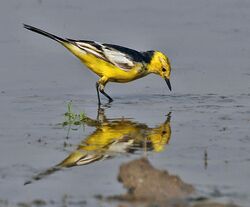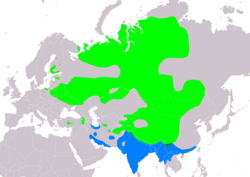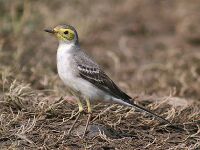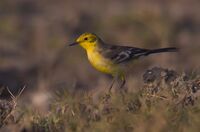Biology:Citrine wagtail
| Citrine wagtail | |
|---|---|

| |
| Male Weigold's citrine wagtail (M. c. calcarata) in breeding plumage Keoladeo National Park, Bharatpur (Rajasthan, India ) | |
| Scientific classification | |
| Domain: | Eukaryota |
| Kingdom: | Animalia |
| Phylum: | Chordata |
| Class: | Aves |
| Order: | Passeriformes |
| Family: | Motacillidae |
| Genus: | Motacilla |
| Species: | M. citreola
|
| Binomial name | |
| Motacilla citreola Pallas, 1776
| |

| |
| Range of M. citreola Breeding Resident Non-breeding
| |
| Synonyms | |
|
Budytes citreola (Pallas, 1776) | |
The citrine wagtail (Motacilla citreola) is a small songbird in the family Motacillidae.
Etymology
The term citrine, and the specific name citreola, refers to its yellowish colouration.
Taxonomy
Its systematics, phylogeny and taxonomy are subject of considerable debate in the early 21st century. This is because this bird forms a cryptic species complex with the eastern (M. tschutschensis ) and western yellow wagtail (M. flava). Which of the many taxa in this group should properly refer to which population is unlikely to be resolved in the immediate future.[2]
Motacilla is the Latin name for the pied wagtail; although actually a diminutive of motare, " to move about", from medieval times it led to the misunderstanding of cilla as "tail". The specific citreola is Latin for "lemon yellow".[3]
Description
It is a slender, 15.5–17 cm long bird, with the long, constantly wagging tail characteristic of the genus Motacilla. The adult male in breeding plumage is basically grey or black above, with white on the remiges, and bright yellow below and on the entire head except for the black nape. In winter plumage, its yellow underparts may be diluted by white, and the head is brownish with a yellowish supercilium. Females look generally like washed-out versions of males in winter plumage.
Distribution
This species breeds in the central Palearctic in wet meadows and tundra. It migrates in winter to South Asia, often to highland areas. Its range is expanding westwards, and it is a rare but increasing vagrant to western Europe. Vagrants seem to extend the migration rather than straying en route; in Bhutan, for example, though along one of the species' migration flyways, the citrine wagtail has been recorded as an extremely rare passer-by rather than staying even for a few days or weeks.[4]
Ecology
It is an insectivorous bird of open country near water, such as wet meadows and bogs, and nests on the ground, laying 4–5 speckled eggs.
Gallery
References
- ↑ BirdLife International (2019). "Motacilla citreola". IUCN Red List of Threatened Species 2019: e.T22718379A154492004. doi:10.2305/IUCN.UK.2019-3.RLTS.T22718379A154492004.en. https://www.iucnredlist.org/species/22718379/154492004. Retrieved 12 November 2021.
- ↑ Voelker, Gary (2002). "Systematics and historical biogeography of wagtails: Dispersal versus vicariance revisited". Condor 104 (4): 725–739. doi:10.1650/0010-5422(2002)104[0725:SAHBOW2.0.CO;2]. http://www.cooper.org/COS/104_4/104_4abs02.pdf. Retrieved 2013-03-21.
- ↑ Jobling, James A. (2010). The Helm Dictionary of Scientific Bird Names. London, United Kingdom: Christopher Helm. pp. 109, 261. ISBN 978-1-4081-2501-4. https://archive.org/details/Helm_Dictionary_of_Scientific_Bird_Names_by_James_A._Jobling.
- ↑ Inskipp, Carol; Inskipp, Tim & Sherub (2000). "The ornithological importance of Thrumshingla National Park, Bhutan". Forktail 14: 147–162. http://www.orientalbirdclub.org/publications/forktail/16pdfs/Inskipp-Bhutan.pdf.
External links
Wikidata ☰ Q206540 entry
 |









